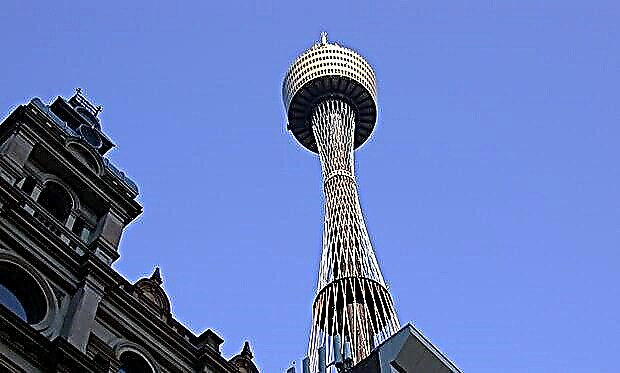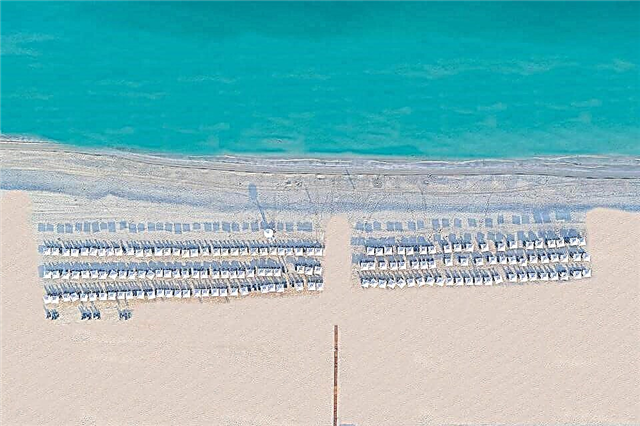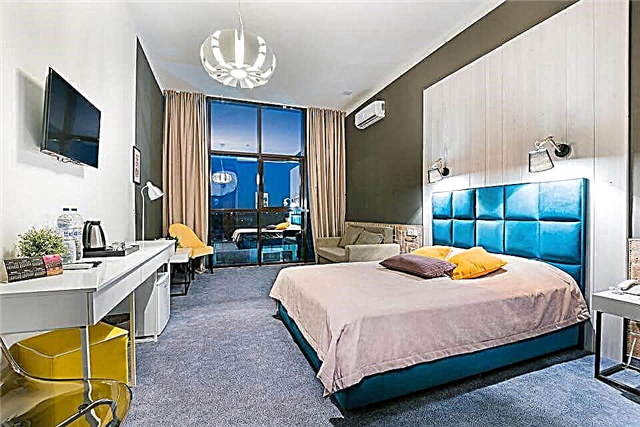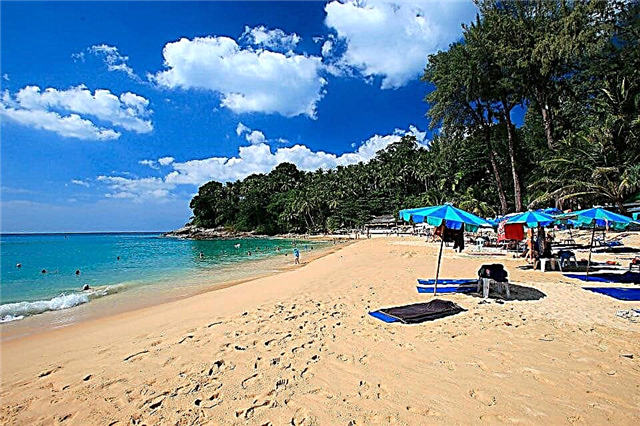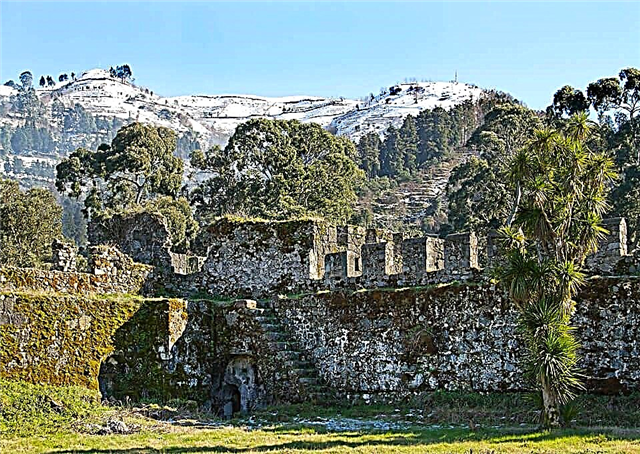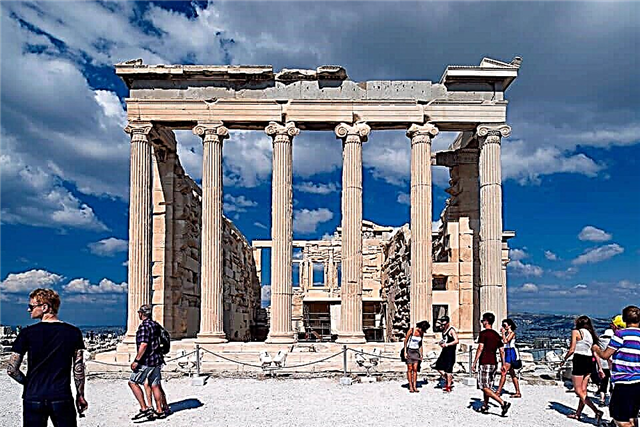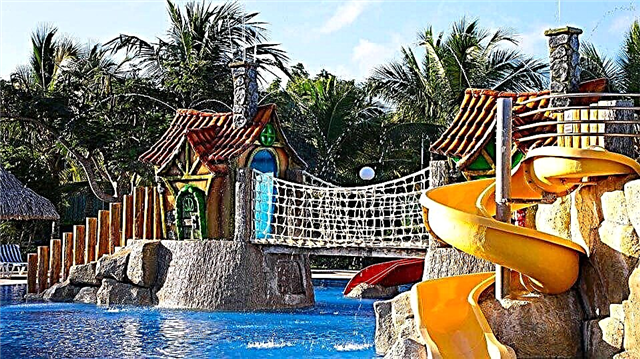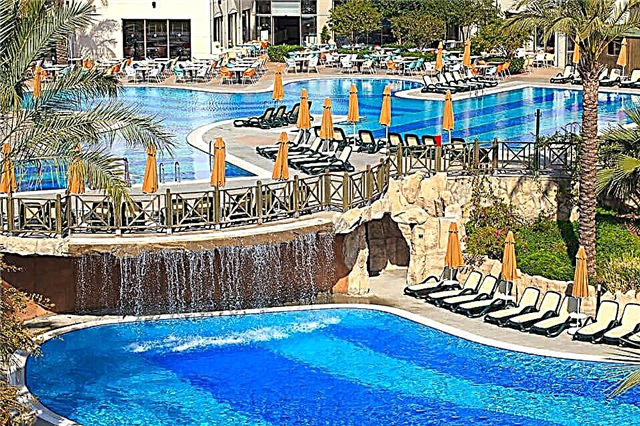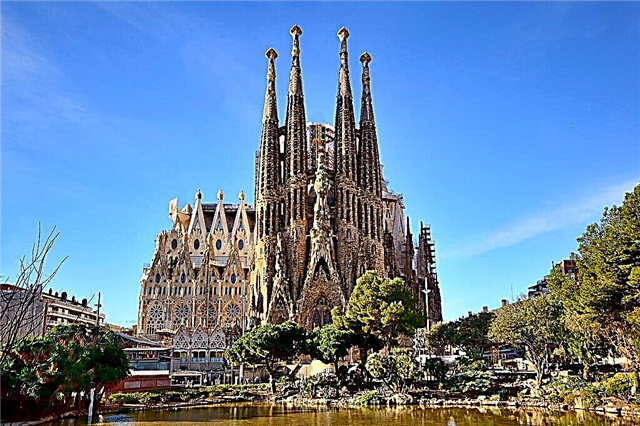Spain is a paradise for travelers. It is a country with an ancient history, with many well-preserved medieval quarters and squares. The magnificent architecture of Antoni Gaudí and kilometers of luxurious beaches of the Atlantic coast and Mediterranean. Spain is rich in natural attractions, the Sierra de Tramontana and the Garajonay Park are protected by UNESCO. In total, there are 48 objects in the country (2019) included in the World Heritage List.

The best hotels and hotels at affordable prices.
from 500 rubles / day
What to see and where to go in Spain?
The most interesting and beautiful places, photos and a short description.
Sagrada Familia
This is the most famous building of the great Antoni Gaudi. Also known as the Sagrada Familia. It is noteworthy that the construction of the temple, which began in 1882, has not yet been completed. The grandiose building is the symbol of the whole of Barcelona and Catalonia. A stately and imposing building began to be built in the Gothic style, but Gaudi introduced the originality of Art Nouveau into its appearance, adding lightness and delicacy to the temple.

Casa Batlló and Casa Mila
Mila House is an architectural monument and a residential building that is included in the UNESCO heritage list. The house with an extravagant facade was built according to the project of Antoni Gaudi. Part of the facade is forged balconies of unusual shape. Now the building houses a museum of Gaudí's works. Another Gaudi creation is interesting with an unusual facade - Casa Batlló. The facade is called "dancing" because of the curved lines in its design.

Gothic Quarter (Barcelona)
In the labyrinth of narrow streets of the quarter, there are many old buildings from the Middle Ages and the Roman Empire. It is easy to get lost or get stuck in the chaotic layout of the quarter, but this does not bother tourists from all over the world who come here to appreciate the beauty of the monuments of historical architecture. In this incredibly beautiful place, Gothic is harmoniously combined with Renaissance and neoclassicism.

Plaza of Spain (Seville)
The semicircular square is located in Seville near the Maria Luisa Park and is one of the brightest in Europe. It is separated by a channel through which graceful bridges are thrown. The square is surrounded by an architectural ensemble of buildings in the neo-Moorish style. The center of the square is decorated with a large fountain. The pavilion on the edge of the square often hosts interesting exhibitions, and in its design features of the Art Deco style can be traced.

Park Guell (Barcelona)
Located on the outskirts of Barcelona. Its construction began in 1901. Antoni Gaudi was also involved in the project of the park. The most famous attraction in the park is a huge winding bench made from shards of pottery, broken glass and other motley construction debris. The park is also decorated with other intricate compositions - fabulous houses at the entrance to the park, the mosaic Salamander and the “hall of 100 columns”.

Rambla (Barcelona)
Pedestrian street just over a kilometer long. It has a special soulful atmosphere of real Spain. The colorful Pla del Os square with Joan Miró's mosaics on the sidewalk, the Boqueria market, the Canaletes fountain with drinking water, churches, palaces and monuments - the street is full of many attractions. For the Olympic Games in 1992, the modern Morskoy Boulevard was added to the street.

Prado National Museum (Madrid)
Opened in 1819 in Madrid. Located in a building of splendid classicist architecture. The museum contains one of the finest collections of paintings in Europe. The funds contain about 7000 paintings. There are canvases by artists from different countries - Flemish, English, German, Spanish. A number of exhibitions are devoted to other types of art - about 1,000 sculptures and almost 5,000 prints. There are halls with arts and crafts and decorations.

Royal Palace (Madrid)
Despite the fact that the palace is officially the residence of the kings of Spain, it is open to tourists. You can see 50 rooms out of 2000. Visitors will not be left indifferent by the interior of the halls and rooms. They are decorated with marble, mahogany, stucco. Several frescoes were painted by Caravaggio and Rubens. Collected unique collections - from weapons and armor to Stradivarius tools.

City of Arts and Sciences (Valencia)
An architectural complex of five buildings for various purposes in the city of Valencia. The modern buildings house a cinema, a planetarium, a theater, a greenhouse, a science museum, a concert hall, and an open-air oceanographic park. The composition is complemented by a grandiose suspension bridge. Its length is 180 meters and the mast height is 125 meters. A beautiful park with streams and pools is laid out around the complex.

Guggenheim Museum Bilbao
Museum of Contemporary Art in Bilbao. It houses exhibitions of both local and foreign artists. The main theme of the work is the avant-garde. There are more installations and electronic works in the museum than traditional paintings and sculptures. There are works by Gerhard Richter and Andy Warhol. The futuristic building of the museum on the banks of the Nervion River evokes many associations with its abstract form among visitors - a spaceship, an airplane or a rosebud.

Reina Sofia Center for the Arts (Madrid)
A museum that houses paintings of contemporary art and about 40,000 books. Most of the collections of paintings are the works of Spanish surrealists and avant-garde artists from the 20th century to the present. The pearl of the art center is the painting by Pablo Picasso "Guernica". One of the areas of the center's work is research. For students, lectures are given on art history.

Palace of Catalan Music (Barcelona)
Concert hall in Art Nouveau style. A feature of its architecture is the natural lighting of the hall. The multi-colored mosaic glass ceiling looks like a dome. A combination of blue and gold colors prevails, which resembles a real sky with the sun. The facade is decorated with frescoes. Inside the hall there are many sculptures - Valkyries from Wagner's opera and Greek muses. The palace hosts world-class performances.

Seville Alcazar
Built on the site of the ruins of an Arab fortress. The construction of the palace began in the 14th century. It is one of the few well-preserved Mudejar palaces. For a long time, the palace was the residence of the Spanish kings. The elegance and luxury of the interior design can be best appreciated in the Ambassadorial Hall of the palace and in the room of Charles V. Stucco moldings and decorative compositions are presented in the Maiden's Patio.

Alcazar in Segovia
One of the most popular destinations in Spain. Located on a high cliff at the confluence of small rivers. The building was erected in the 9th century as a fortress, later it was rebuilt into a palace. Now the palace houses a museum. Old interiors have been recreated, collections of weapons, furniture and portraits of kings are exhibited. The throne room, the stone hall and the hall with Venetian stained-glass windows are especially popular with tourists.

Alhambra (Granada)
A grandiose architectural ensemble in Granada, the main buildings were erected in the XII-XV centuries during the reign of the Muslim dynasty. Behind the fortress walls there are mosques, baths, residential buildings. The beautiful gardens are in harmony with the buildings of Islamic architecture. Among the cypresses and orange trees, there are several small ponds and fountains. The bubbling water creates a special mood.

Toledo Alcazar
The first defensive structures on this site began to be built by the ancient Romans.The fortress repeatedly passed from hand to hand, until in 1486 Pedro I decided to rebuild the castle, and Charles V completed its re-equipment, making a palace out of the fortress. The historical monument is loved by tourists. Walking along the thick walls of the fortress are allowed. Within the walls of the alcazar there is a Military Museum and a large library.

Burgos Cathedral
Cathedral of Catalonia. Built in the Gothic style. Catalan graceful motives give it a pretentious rosette over the main entrance, turrets directed to the sky and columns. Founded in 1221, however, the construction of the cathedral was not carried out for 200 years. It ended only in 1567. It is an architectural monument and is included in the UNESCO heritage list. A lush garden is laid out in the courtyard of the cathedral.

Seville Cathedral
One of the largest cathedrals in Europe in the Gothic style. It is 116 meters long and 76 meters wide. Its construction was completed in the 16th century. It is believed that it contains the burial place of Christopher Columbus, and the cathedral cross is cast from gold that the navigator brought from America. Among the many treasures of the cathedral are paintings by great painters - Goya, Velazquez, Murillo. The cathedral is also famous for its organ concerts.

Mesquita (Cordoba)
In the past, it was a mosque - the most magnificent in the city. Thousands of tourists travel to Cordoba to see the masterpiece of architecture with their own eyes. Giant double arches inside the building are connected by hundreds of columns. For the manufacture of columns used marble, onyx, granite, jasper. The blue dome is decorated with gold-colored star tiles. The prayer hall consists of five zones, each with its own architectural features.

El Escorial Monastery
Built in the 16th century by King Philip II. The construction took over 20 years. The result is a Renaissance-style architectural complex consisting of churches, a palace and cozy courtyards. The monastery has museums telling about the history of El Escorial and keeping a collection of works by artists of the 15th-17th centuries. Members of the Spanish royal family are buried in the church's pantheon.

Nuestra Senora del Pilar (Zaragoza)
In translation, the name of the cathedral means the Cathedral of the Virgin Pilar. It is an ancient basilica built in the Baroque style. The first Christian chapel was built on this site in the II century BC, the domes of the modern church were completed in 1961. The church has 11 domes in total. In the center of the church is a jasper column topped with a 15th century statue of Mary. The frescoes of the dome were made in the 18th century. Several vaults were painted by the great Goya.

Cathedral of Saint James (Santiago de Compostela)
The relics of the holy Apostle James are buried in the cathedral in the north of the country. Considered one of the great shrines of Spain. Another shrine is the thorn of thorns from the wreath of Jesus. The construction of the cathedral began in 1211, and it took another 400 years to build. The cathedral does not have a single architectural style, but it stands out with an imposing baroque façade. Inside is one of the world's largest censers - the size of a man's height and weighing 80 kg.

Cuenca city
A small beautiful city, the historical center of which is included in the UNESCO list. It is located on a rocky picturesque cliff above the gorge. From the side, ancient houses seem to grow out of rocks, they are called "hanging houses". The atmosphere of antiquity is created by architectural monuments - a Gothic cathedral, monasteries and churches, an episcopal palace, many museums. In September, the festival of St. Mateo is held here, which is celebrated by the entire city.

Aqueduct in Segovia
Ground section of the ancient Roman aqueduct. The date of its foundation is not known exactly, but most scientists are inclined to believe that it was built in the 1st century. Included in the UNESCO heritage list. It is 728 meters long and 28 meters above the ground. The building was erected from granite blocks, not fastened to each other in any way. It is a stone bridge with many arched spans.

Roman Theater (Merida)
Theater of ancient times, built before our era. Included in the architectural ensemble of the city of Merida, which is a UNESCO heritage site. Several fragments have survived to this day, and many tourists come to see them. The theater is designed in the form of a semicircular amphitheater; some of the auditoriums are located on the hillside. On the stage of the theater, the Festival of Classical Theater is held annually.

Tower of Hercules (La Coruna)
An ancient Roman lighthouse located on a cliff over 50 meters high in A Coruña. The height of the tower itself is 55 meters. The lighthouse is a UNESCO protected site. Tentatively built in the 2nd century and still in use today. The walls of the tower are made of granite and are 2 meters thick. The name was given in honor of one of the exploits of Hercules. According to legend, Hercules built the tower himself after defeating the giant Geryon.
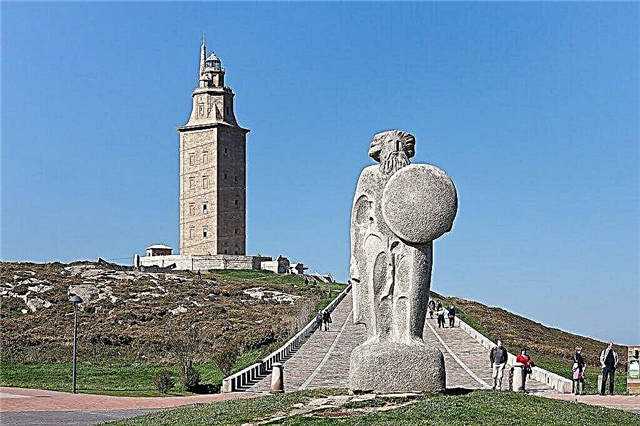
Bridge of Biscay (Portugalete)
A conveyor bridge, which is called a "flying ferry". On the banks of the river there are two towers 60 meters high. A gondola moves along the central aisle between them. It accommodates up to 6 cars and several dozen people. The gondola leaves every 8 minutes, and the journey from one bank to the other takes 1.5 minutes. The bridge was built in 1893 and for that time it was a great engineering achievement.

Puente Nuevo (Ronda)
Built in the 18th century across the Guadalevin river gorge. The depth of the El Tajo gorge is 120 meters. The three-arch bridge, 98 meters high, was built of stone. Built instead of a collapsed single-arch bridge. More than 50 people died in that disaster. The observation deck on the bridge is a popular tourist spot. It offers a magnificent view of the river valley and almost the entire city of Ronda - its historical and new part.

Altamira cave
The cave is naturally formed. Its length is 270 meters. The height of the main halls reaches 6 meters. The stone paintings of the Paleolithic era have been preserved in the caves - specialists in paleontology from all over the world come to explore them. They believe that the cave was used by humans around 35,000 years ago. The unique painting of the vaults amazes many scientists. Many people call the painting of the cave "the Sistine Chapel of primitive art."

Teide National Park
Located on the popular tourist island of Tenerife. Its territory is located on a volcanic base. The height of the volcanic formation is 7500 meters. The base of the volcano is at the bottom of the Atlantic Ocean. The highest point of the park is Mount Teide of the same name - 3718 meters. The desert landscape of the park is interesting for bizarrely shaped rocks made of solidified lava. A third of the park's flora grows only in this place.

Garajonay National Park
The name is associated with the tragic story of Prince Honai and the girl Gar. The princes' parents were against their wedding, and the lovers took their own lives. The territory of the park is included in the UNESCO heritage list. Most of it is covered by subtropical evergreen forest. Many plant species grow only on the territory of this national park. The park is open to visitors and has trails for hikers.

Sierra de Tramontana
Mountain range 90 km long in Mallorca. It stretches from Cape Sa-Mola to Cape Formentor. This area is home to many cultural and ethnic values. The territory of the mountains and historical monuments on them is a UNESCO site. The natural landscape is harmoniously complemented by man-made buildings - stone terraces for growing olives, "snow" houses for storing blocks of snow and ice. Excursions to mountain gorges and peaks are interesting.

Dunes of Maspalomas
Sand dunes by the ocean. Many travelers resemble a corner of the Sahara Desert in their appearance. The dunes are constantly in motion under the influence of the east wind. The protected area covers 404 hectares. The ecosystem of the park also includes the La Charca sea lagoon. It is separated from the ocean by a sand bar. The flora and fauna of the territory is unique. Some insect species are found only here or in Africa.

La Concha beach (San Sebastian)
The name of the beach is translated as "shell" - this is the shape of the bay at this beach. The beach is about one and a half kilometers long. It consists of sand dunes with golden soft sand. The beach bay is sheltered from the wind. There are practically no waves, so La Concha beach is ideal for families with children. The beach infrastructure is excellent. Not far from the beach area there are interesting sights - palaces and fortresses.

Loro park
Zoo located on the island of Tenerife. Since its opening in 1972, it has been visited by over 40 million people. Popular with an extensive collection of parrots. The number of individuals reaches 4000. Other inhabitants are represented by different species of primates, reptiles, fish and birds. The show of sea lions and killer whales takes place in one of the largest dolphinariums in Europe. An interesting place is the "Thai Village" at the entrance to the park.

The best places to stay in Spain
Costa Brava
This picturesque natural area on the Catalan coastline is popular with tourists and locals alike. It has many beach resorts and outdoor activities. Popular walks along the gorges and spurs of the Pyrenees among the dense coniferous forest, overlooking the bays and bays. There are many monuments of ancient culture in the city. In the evening, entertainment parties are held on the beaches.

Ibiza Island
Known all over the world for parties and discos, which are attended by thousands of people from all over the world. There are many electronic music clubs on the island and they are never empty during the summer. In the north, there are secluded resorts more suitable for relaxing sea and sun enjoyment. There are also historical sights in Ibiza - a castle of the XII century and buildings of the Renaissance.

Canary Islands
The archipelago, loved by tourists for its mild climate all year round and picturesque nature. 7 islands conquer the hearts of vacationers with a tropical landscape, deep blue ocean waves and excellent tourist service. Snow-white, golden and even black volcanic - on each island the sand is of a different color. Diving is popular among entertainment - the underwater world of the islands is incredibly interesting.



